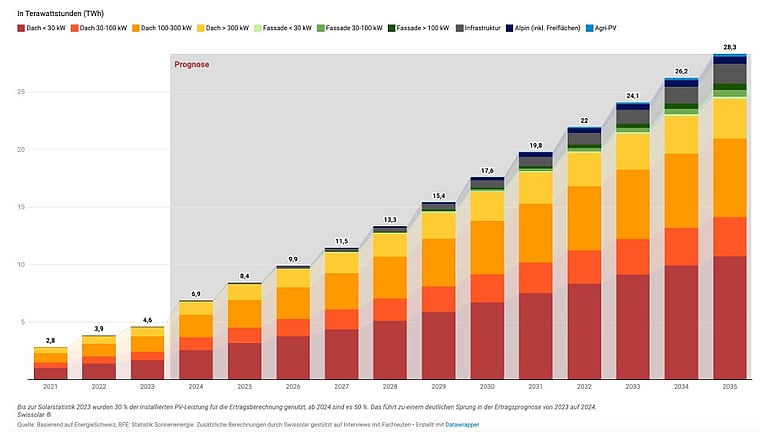Solar Can Contribute 80% To Switzerland’s Electricity Expansion By 2035
Source:taiyangnews

Swissolar expects solar installations under 30 kW capacity to lead the country’s new additions till 2035 when the technology is likely to contribute over 28 TWh capacity. (Photo Credit: Swissolar)
Key Takeaways
Swissolar expects solar energy to account for around 80% of the 35 TWh renewable energy target by 2035
New applications and supportive regulatory framework will contribute to this growth
The industry will need to increase full-time positions from around 11,000 now to up to 19,000 within the next 10 years to achieve the target
Switzerland aims to have renewable energies accounting for 35 TWh of annual supply by 2035. Solar power alone can contribute over 28 TWh or around 80% of the Swiss Electricity expansion, according to the local solar energy association Swissolar, provided it is supported by suitable framework conditions and market models.
Some of the newer applications that can boost the capacity, in addition to classic rooftop installations, will be installing solar on façades, on infrastructure or in combination with agricultural crops or agrivoltaics. Most of the anticipated growth will come from solar systems with under 30 kW capacity, followed by those within 100 kW to 300 kW capacity.
Swissolar makes this forecast in its new annual publication Swiss Solar Monitor which aims to provide a holistic picture of the Swiss solar market. The report includes a detailed survey of industry players and records industry turnover for the 1st time.
In 2024, the Swiss solar market turnover is expected to be around CHF 3.7 billion ($4.17 billion) and projected to exceed CHF 6 billion ($6.77 billion) within the next decade.
According to the report writers, to achieve the 35 TWh expansion target set out in the country’s Electricity Act, the number of around 11,000 full-time equivalents in the Swiss solar industry needs to go up to 19,000 full-time positions.
According to the report, Switzerland’s solar energy market has been growing by up to 60% annually. By the end of 2024, it is expected to contribute around 11% to the country’s electricity needs. In August 2024 at peak times, it covered as much as 20% of the final electricity consumption.
Solar energy is on its way to becoming the 2nd mainstay of the country’s electricity supply alongside hydropower. Nevertheless, the introduction of the new electricity law is creating uncertainties, the report points out.
Reportedly, the Swiss Federal Council has approved revisions to the Energy Promotion Ordinance (EnFV) and parts of the Energy Ordinance (EnV), along with the Electricity Supply Ordinance as part of the Electricity Act. These changes are due to come into force on January 1, 2025.
Swissolar welcomes the additional funding support for façade systems and carports to expand PV. Yet, it rues the fact that the changes adopted do not raise the minimum share of electricity from domestic production of renewable energy in the basic supply from 20%. It advocates a ‘binding expansion path’ to ‘fully supplying Switzerland with electricity from renewable energies.’
The association adds, “However, the minimum remuneration for the electricity fed into the grid is crucial for the economic operation of photovoltaic systems. This will not be regulated until the first quarter of 2025 and will come into force on January 1, 2026. Swissolar appeals to the Federal Council to take appropriate account of the economic viability of all building and system categories so that the necessary expansion is not slowed down.”
Due to this uncertainty, the association projects a slight decline in installations in 2025 and 2026.
The complete report is available on Swissolar’s website for free download.
